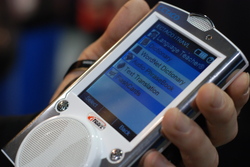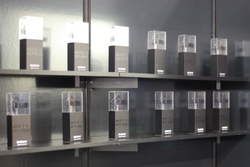I spent this week at what is probably the largest tradeshow in the world. The sheer size of CES means that information overload is inevitable, and the consistent challenge for any exhibitor at a show like this is rising above the clutter. If you think about it, this challenge is no different from any other tradeshow or exhibition … though CES is surely more difficult to stand out at than most. Throughout the show, there were a few vendors that did do something noteworthy to stand out. This post is about how they did it and some marketing lessons you can learn from their efforts.

Now for all I know there are 12 vendors that all make the same product and this company is no different than any of them. So what made this one so different? I think the answer lies in 5 critical things that the product manager with whom I spoke, Boris Krol, managed to do to help his product stand out from others:
- Get a third party endorsement: I did not meet Boris at an ordinary booth, I met him outside a display case where his product was showcased as a 2008 Innovation Technology and Engineering Award winner. As a result, I was already predisposed to listen to his pitch because the show’s organizers had already picked his product as one of the best. This is a basic ingredient of PR, but one that matters: get someone else to talk about how great you are so you don’t have to.
- Be where your competitors aren’t: This is often the one thing that makes a brand or product stand out more than anything else. If you have been to any interactive marketing tradeshow, you’re probably used to having dozens of booths of affiliate marketing networks lined up next to one another. This may work in the real world when you put gas stations near each other, but when it comes to tradeshows it is the kiss of death. Being lined up in the same location makes it infinitely harder to stand out. In Boris’ case, he was the only vendor standing next to his product in the Innovation Awards area and giving a demo. As a result, he had an uncontested opportunity to promote his product.
- Market outside of what you paid for: A big mistake that many exhibitors make at tradeshows is sticking to what they believe they have paid for. This means only marketing from a booth, following all the rules of the event and not venturing out. This is the easy path, and one that is often taken because the staff at a booth is not incentivized to do more. If you think about the tradeshows that you have been to, the brands that stand out most are the ones that are wandering the halls, attending and asking questions at sessions, and generally taking a more proactive and guerilla approach to marketing. Boris was likely not supposed to demo his product on the floor, but he did and it worked.
- Know your hook. Boris’ hook was asking people where they were from so he could demonstrate how his product worked in their language. In my case, that meant showing me the Hindi functionality (a language I did not expect his device to handle, quite frankly). This was his hook that personalized each demonstration. It is also something that many vendors forget as they get caught up in talking about their products and leave out having something relevant to talk about.
- Have something worth talking about. This will likely be the toughest piece of advice to follow, but in order to really stand out at a tradeshow, you can’t be hawking a product that is crap or a service that is identical to everyone elses. Some marketers could argue that this is simply a branding challenge. Perhaps it is … but let’s remember when you talk about tradeshows, you are usually talking about standing out in a place where people generally know what they are looking for and are informed about it. Bullshit meters are high and branding alone is unlikely to solve your problem. Even if you are able to generate buzz about a substandard product or service, it will not last once people uncover the truth about your solution. Boris’ product actually worked, and it was worth talking about.
In addition to the automated translator, there were a few other marketing lessons from elsewhere in the event. Here are a few other lessons I would add to the list of things to consider the next time you are exhibiting at a tradeshow which don’t relate to Boris and his automatic translator, but are interesting nonetheless:
Spend on the giveaways, not the booth. Everyone knows that nothing spreads faster at the tradeshow than a brand with a really big or valuable giveaway. In fact, one of the booths that had great buzz at the event was a tiny (but well located) small booth in the Concierge tent from Jawbone – a maker of high quality bluetooth headsets. The booth was tiny and could not have costed more than a few thousand dollars to create. No expensive signage or flashy lights … yet they were doing a Bluetooth headset trade-in where you could give them your old one and they would give you a new Jawbone (valued at $119 retail). It was a great promotion for a small company to generate big buzz. We also used this lesson for a great Virgin America promotion (a client) at the CES Blogger Party.
- Reach out to the right influencers ahead of time. A key to maximizing the benefit of your sponsorship and display at a large tradeshow event is to do as much prep as you can to identify the influencers you want to meet. After my post last week about the NBC Universal booth, I was contacted by a company called MediaPort to check out their kiosk solution which NBC was using for their instant content downloads. As a result, I went by their booth, got a demo of their solution and maximized my time there as well by knowing who to ask for. The solution was relevant, the outreach was smart, and as a result they are mentioned here.
All in all, CES was a great place to learn about marketing at tradeshows simply because there are so many examples and techniques people are using. Standing out at a Tradeshow is not an easy thing to do. Standing out at CES is even harder. If you have a show that you are exhibiting at coming up, hopefully this list of ideas helps you get ready to see the most benefit from it. Let me know if any of these ideas work for you.







WE RECENTLY REMOVED COMMENTING - LEARN WHY HERE >